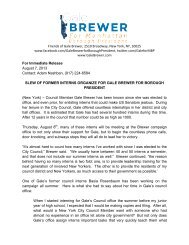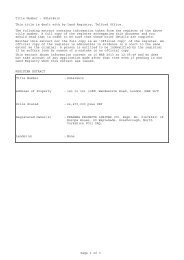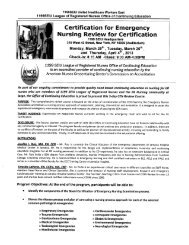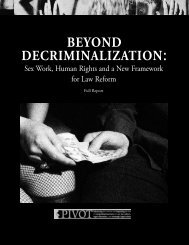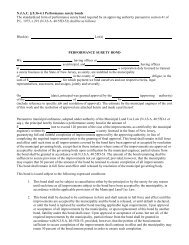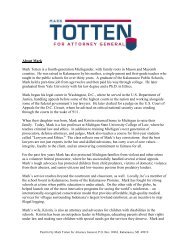Position Paper, October 16, 2013 Restore State Revenue Sharing ...
Position Paper, October 16, 2013 Restore State Revenue Sharing ...
Position Paper, October 16, 2013 Restore State Revenue Sharing ...
You also want an ePaper? Increase the reach of your titles
YUMPU automatically turns print PDFs into web optimized ePapers that Google loves.
<strong>Position</strong> <strong>Paper</strong>, <strong>October</strong> <strong>16</strong>, <strong>2013</strong><strong>Restore</strong> <strong>State</strong> <strong>Revenue</strong> <strong>Sharing</strong> Funded by Progressive Taxation:The Once and Future Solution to the City's Fiscal CrisisBy Kevin Bott and Howie HawkinsThe authors are Green Party candidates in Syracuse: Kevin Bott for Mayor and Howie Hawkins for 4 thDistrict Councilor.Every issue our city faces is contingent on one overriding issue in this year's election: the financialemergency. Syracuse faces a Detroit-style takeover of the city and a Philly-style takeover of the schooldistrict in the next two or three years. What's at stake is whether we will still have the democratic rightto address our problems together in a city government that we elect. Or whether the state will appointagents of big business and Wall Street to rule over us through a Financial Control Board and anEducation Oversight Board.The once and future solution to the fiscal crisis is to restore the kind of revenue sharing funded byprogressive taxation that was adopted by the state in 1970. Starting in late 1969, Syracuse Mayor LeeAlexander, New York City Mayor John Lindsay, and the other Big 6 Mayors campaigned for monthsfor revenue sharing of progressive state taxes because the underlying cause of the fiscal crises that ourstate's cities faced then is the same cause we face today: the replacement of property tax-payingmanufacturers with tax-exempt universities, hospitals, and government agencies. The solution then isstill the solution today.But the Democrats in power – from Governor Cuomo on down to the city Democrats, who hold everyelected office in the city – offer nothing but more cuts to schools, services, and city workers. TheRepublicans at every level just shout Amen! to Democrats' austerity policies.Cuomo calls for fiscal self-reliance on a limited taxable property base, and if that fails, consolidationimposed by a Financial Control Board. Syracuse needs about $1 billion in new taxable property to raisethe $24 million a year in additional revenues over the next three years that is needed cover projectedbudget gaps. That won't happen. The city only has $3.7 billion in taxable property now. Fiscal selfrelianceis fiscal fantasy for Syracuse. Perhaps that is Cuomo's intention because he wants to forceconsolidation. Consolidation certainly reshuffles responsibilities, but its cost savings are limited.Cuomo's urban austerity policy is a recipe for a continuing downward spiral of school and service cuts,property tax hikes, privatization of public services and assets, a further exodus of homeowners andbusinesses seeking decent schools and municipal services, and a further reduction in the city's propertytax base.To her credit, Mayor Miner has accurately described how the economic model of New York's centralcities is not sustainable. Tax-paying manufacturing businesses have largely been replaced by taxexemptuniversities, hospitals, and federal, state, county, and city government agencies, which serve asthe economic base and major employers in our metropolitan regions.But this is old news. This economic transition mostly occurred in between World War II and 1970 asmulti-story factories in the central cities were abandoned in favor of sprawling one-story plants in thesuburbs. It was in recognition of this change in the economies of metropolitan regions that the stateagreed to revenue sharing in 1970.Instead of calling for restoration of previously promised levels of revenue sharing, Miner has focused
on state labor law changes that would give the city administration leverage in contract negotiations tocut city workers' wages and benefits. City workers don't get enough to give back anywhere near $24million a year.Miner also calls for municipal and state leaders to meet and cut a deal to rescue the cities. That is aprocess, not a policy. We need a popular campaign for fiscal justice, not a elite deal that once againmakes working people bail out Wall Street bondholders with cuts to city services and schools, wageand benefit cuts to city workers, and regressive tax hikes.Governor Rockefeller then, like Governor Cuomo today, at first said the state “cupboard is bare” whenthe Big 6 mayors proposed revenue sharing. But popular support for the reforms turned Rockefellerinto a champion of them in the end. It is time for our city elected officials, in concert with civic groups,labor unions, and other municipalities' elected officials, to once again campaign for the state to pay forits unfunded mandates on local government.The City of Syracuse, with a $299 million operating budget this year, projects a budget gap of $73million over the next three years: $18 million in the current fiscal year, $25 million next year, and $30million the following year. With a cash reserve of $61 million at the beginning of this fiscal year,Syracuse will reach the state Comptroller's recommended minimum level of 5% of revenues by the endof next fiscal year.The school district, with a $367 million budget this year, has only $8 million left in cash reserves. Thedistrict has already cut one-quarter of its staff over the last four years. Our schools need money, nothigh-stakes testing and teacher evaluations designed to fail the schools and justify privatization intocharters. See Philadelphia, Chicago, Milwaukee, New Orleans, Newark, Detroit, and other cities forthat script. Public school closings and private charter school openings have not improved studentachievement.Governor Cuomo told Syracuse in June that city budget is not balanced because the state fundingaccounts for 24 percent of the city operating budget and not to expect more state funding. Never mindthat the state gets 31 percent of its budget from the federal government. Instead, he told us, "Maybe wehave to merge a city with a county."Lt. Governor Duffy began the year by coming to Syracuse to say the city should ask the state now for aFinancial Control Board if the city doesn't think smoothing pension costs over multiple years issufficient state mandate relief. He added that the board would have the power to break union contractsand impose cuts in city workers' wages and benefits.Then in mid August, Cuomo's Education Commissioner, John King, called for passage of a bill toenable the state Board of Regents to replace elected school boards in districts that are failing financiallyor academically with state-appointed Education Oversight Boards, which he described as akin toFinancial Control Boards for cities. Governor Cuomo soon followed that announcement up with hisown call for “a death penalty for failing schools,” followed by a state takeover and privatization intocharter schools.Cuomo told us in June, “You can't be reliant on the state to come in here with a check at the end of theyear to make up for the shortfall that you can't fill because, frankly, the state's not in a position to dothat anymore.”We disagree. We know where the money is. That rich have it. Since 1980, the per capita gross stategross product has tripled in inflation-adjusted dollars. But all the growth in income went to the top 1percent, who received 10 percent of all state income in 1980, but had 30 percent by 2012.
In the meantime, taxes on the rich were cut. The stock transfer tax, which brings in about $15 billion ayear, has been 100 percent rebated to the traders since 1981. Since 1980, the top bracket tax rate hasbeen cut in half and the bottom bracket tax rate doubled. <strong>Revenue</strong> sharing was the first thing to be cutto pay for these top end tax cuts.The revenue sharing formula was revised a few times in the 1970s, but by 1979 the state settled onstatutory level of 8 percent of (<strong>State</strong> Finance Law, Section 54). But to pay for repeated top end tax cutsand to balance the budget during recessions, the annual state budget resolutions included“notwithstanding” clauses that exempted the budget from the 8 percent revenue sharing requirement.<strong>Revenue</strong> sharing was repeatedly reduced. Today it is less than 1 percent of state revenues and GovernorCuomo's 5-year financial plan keeps it flat in inflation-adjusted dollars at $775 million out of a $90billion general fund budget.Syracuse gets $72 million of that revenue sharing. If New York <strong>State</strong> just restored revenue sharing tohalf of its once promised 8 percent, that 4 percent would be close to the average for revenue sharing inthe 50 states and yield over $200 million more in revenue sharing funds for Syracuse. We would befiguring out how to use that money to address pressing city problems, including high property tax rates.On the school side, the state has accumulated an $8.9 billion shortfall in promised funding from theFoundation Aid Formula enacted in 2007 to address the underfunding of urban education in thesuccessful lawsuits won by the Campaign for Fiscal Equity.These increases in revenue sharing and school aid could be easily funded by modest increases inprogressive taxation. To bring the state revenue sharing budget back up to 4 percent of state revenueswould require an additional $2.3 billion in revenues without affecting other items in the state budget. Apartial retention of the $15 billion a year stock transfer tax would do it. If we restored the progressivestate income tax structure of the 1970s, with 14 graduated rate brackets instead of six, 95 percent ofNew Yorkers would get a tax cut but the state would take in an additional $8 billion more, which wouldjust about cover the state's cumulative shortfall in promised school funding since 2007. One of the Big6 mayors' other proposals in 1970 was to fund public schools completely with state income taxesinstead of local property taxes. It is time to revive that proposal.These are not soak-the-rich proposals. They are proposals for fiscal responsibility. The rich can afford alittle higher tax rate in the top brackets in order to save our cities and schools.Syracuse is being set up for failure and a state takeover by the fiscal policies now in force. TheDemocrats have not challenged these policies, perhaps fearing a challenge to their incumbency as wesaw visited this year upon councilors Lance Denno and Jean Kessner who questioned some of theMayor's priorities and were refused their party's endorsement when they sought re-election.As Green Party candidates, we are independent of the machine and free to speak up for Syracuse todemand fiscal justice for our cities and schools. That is what we will do if elected.






